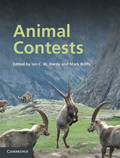13 results
Preface
-
-
- Book:
- Animal Contests
- Published online:
- 05 June 2013
- Print publication:
- 30 May 2013, pp xxi-xxiii
-
- Chapter
- Export citation
15 - Human contests: evolutionary theory and the analysis of interstate war
-
-
- Book:
- Animal Contests
- Published online:
- 05 June 2013
- Print publication:
- 30 May 2013, pp 321-334
-
- Chapter
- Export citation
4 - Analysis of animal contest data
-
-
- Book:
- Animal Contests
- Published online:
- 05 June 2013
- Print publication:
- 30 May 2013, pp 47-85
-
- Chapter
- Export citation
Acknowledgements
-
- Book:
- Animal Contests
- Published online:
- 05 June 2013
- Print publication:
- 30 May 2013, pp xxiv-xxiv
-
- Chapter
- Export citation
Index
-
- Book:
- Animal Contests
- Published online:
- 05 June 2013
- Print publication:
- 30 May 2013, pp 342-357
-
- Chapter
- Export citation
16 - Prospects for animal contests
-
-
- Book:
- Animal Contests
- Published online:
- 05 June 2013
- Print publication:
- 30 May 2013, pp 335-341
-
- Chapter
- Export citation
Frontmatter
-
- Book:
- Animal Contests
- Published online:
- 05 June 2013
- Print publication:
- 30 May 2013, pp i-vi
-
- Chapter
- Export citation
List of contributors
-
- Book:
- Animal Contests
- Published online:
- 05 June 2013
- Print publication:
- 30 May 2013, pp viii-x
-
- Chapter
- Export citation

Animal Contests
-
- Published online:
- 05 June 2013
- Print publication:
- 30 May 2013
1 - Introduction to animal contests
-
-
- Book:
- Animal Contests
- Published online:
- 05 June 2013
- Print publication:
- 30 May 2013, pp 1-4
-
- Chapter
- Export citation
5 - Contests in crustaceans: assessments, decisions and their underlying mechanisms
-
-
- Book:
- Animal Contests
- Published online:
- 05 June 2013
- Print publication:
- 30 May 2013, pp 86-112
-
- Chapter
- Export citation
Abbreviations
-
- Book:
- Animal Contests
- Published online:
- 05 June 2013
- Print publication:
- 30 May 2013, pp xxv-xxvi
-
- Chapter
- Export citation
Contents
-
- Book:
- Animal Contests
- Published online:
- 05 June 2013
- Print publication:
- 30 May 2013, pp vii-vii
-
- Chapter
- Export citation



